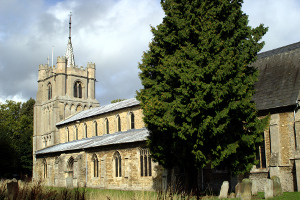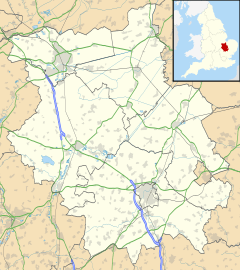Elm, Cambridgeshire facts for kids
Quick facts for kids Elm |
|
|---|---|
 All Saints Church, Elm |
|
| Population | 3,962 (2011) |
| OS grid reference | TF477062 |
| District |
|
| Shire county | |
| Region | |
| Country | England |
| Sovereign state | United Kingdom |
| Post town | Wisbech |
| Postcode district | PE14 |
| Dialling code | 01945 |
| Police | Cambridgeshire |
| Fire | Cambridgeshire |
| Ambulance | East of England |
| EU Parliament | East of England |
| UK Parliament |
|
Elm is a village and civil parish located in the Fenland District of Cambridgeshire, England. In old records from the Domesday Book, it was known as Helle.
The village is about 2.5 kilometers (1.5 miles) south of the market town of Wisbech. It sits right next to the Wisbech by-pass. The border with Norfolk county is just to the north and northeast. The northern part of Elm, especially around Elm Low Road, acts like a suburb of Wisbech. Most of the village is built along the B1101 road, which winds its way between Wisbech and March.
In 2011, the population of Elm, including nearby areas like Coldham, Collett's Bridge, Friday Bridge, and Ring's End, was 3,962 people.
Contents
Exploring Elm's Past
Ancient Times
Elm is located in an area called the Fens. Long ago, much of this land was a salty marsh or lagoon. Any higher areas, like the one around Wisbech, were like islands in the fen. People from the Mesolithic period (Middle Stone Age) lived here. They would hunt and fish for birds from these islands. Later, farmers brought their sheep and other animals to graze on the marshy fields. Tools made of flint have been found in places like Coldham.
Roman Era
People also lived in the Elm area during the Roman period. Everyday items from Roman times have been found throughout the parish. Many of these finds are along the Leam stream. This stream might have been made into a canal by the Romans. Besides farming, there is proof that people processed salt in the Elm area during Roman times.
Medieval Period
The Great Hey, also known as High Fen, was a shared area for several villages, including Elm. As the land was drained and sea levels dropped, Elm likely became a settled village during the medieval period. By the 13th century, the parish was wealthy enough to build a large and important church.
Modern History
The lower parts of Elm parish were probably not fully drained until the 17th to 19th centuries. Later, smaller settlements grew south of the village. These included Friday Bridge and Coldham, located near the Leam stream. These areas had better drainage.
Elm once had a stop on the Wisbech and Upwell Tramway. This stop was called Elmbridge. It was just over the border in Norfolk, near a bridge that crossed the old Wisbech Canal. There were also passenger train stations serving the parish. Coldham station opened in 1847, and Guyhirn station opened in 1867.
The Wisbech Canal connected the River Nene at Wisbech to other waterways. It ran along the northern edge of Elm. The canal was eventually closed and filled in during the 1970s. Parts of it have been turned into a public path. This path starts at the post office and ends at the site of Collets Bridge. The tramway that ran beside the canal closed to passengers in 1927. The entire line stopped operating in 1966.
Besides small gardens and market farms, many apple, pear, and plum orchards were planted. These were on the better-drained soils near the village center. Further out, the lower peat soils are used for growing high-quality crops. The orchards used to attract fruit pickers from London for working holidays. After the Second World War, many of these seasonal workers stayed at a former POW camp at Friday Bridge. Today, this camp is mainly used by seasonal farm workers, including some from other countries.
A stream called The Leam once flowed from March to Wisbech, passing through the village and by the church. This stream has now been drained. Today, it only exists as a pond south of Elm, at Friday Bridge. In 2018, the Elm parish council arranged for the removal of bulrushes from this pond.
Community Life in Elm
Elm has several useful facilities for its residents. These include a primary school, a post office, a local shop, a butcher, hairdressers, and garages. There are also two pubs: The Sportsman and the Elm Tree Inn. A bus service stops in Elm, connecting Wisbech and March. The closest train station is in March. National Cycle Network 63, which goes from Wisbech to Burton on Trent, passes directly through the village.
Important Buildings and Sights
The parish church is a large stone building with a tall, pointed spire. It was mostly built in the 13th century and is dedicated to All Saints. The church is a Grade I listed building, meaning it is very important historically.
Other notable buildings in Elm include Elm House, which is a Grade II listed building. It dates back to 1630. The Sportsman public house is also a listed building. There are nearly two dozen listed buildings in the parish.
Famous People from Elm
- Thomas Aveling (1824-1882) was born in Elm on September 11, 1824. He was a pioneer in agricultural engineering. He later moved to Hoo in Kent. Thomas Aveling was one of the founders of Aveling and Porter. This company became the largest maker of steam rollers in the world. He passed away on March 7, 1882, and is buried in the churchyard at St Werburgh Church in Hoo.




